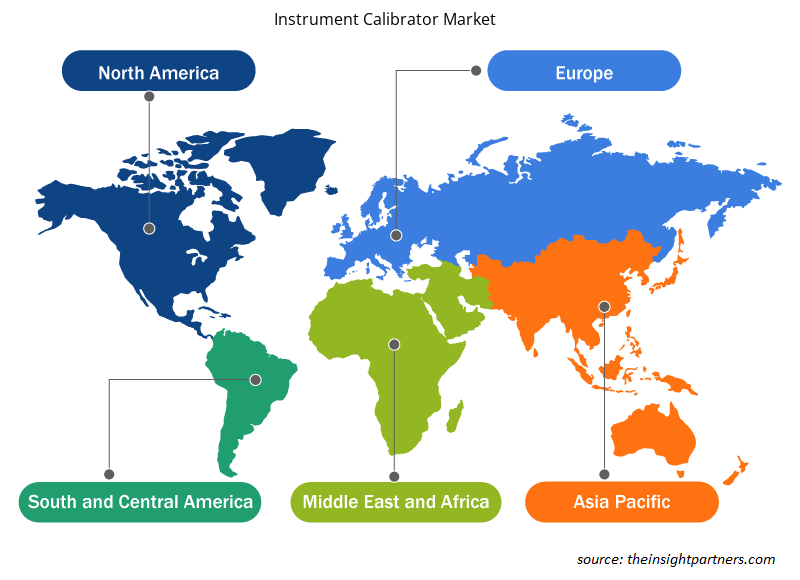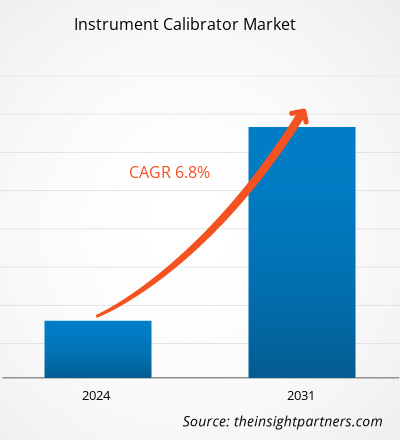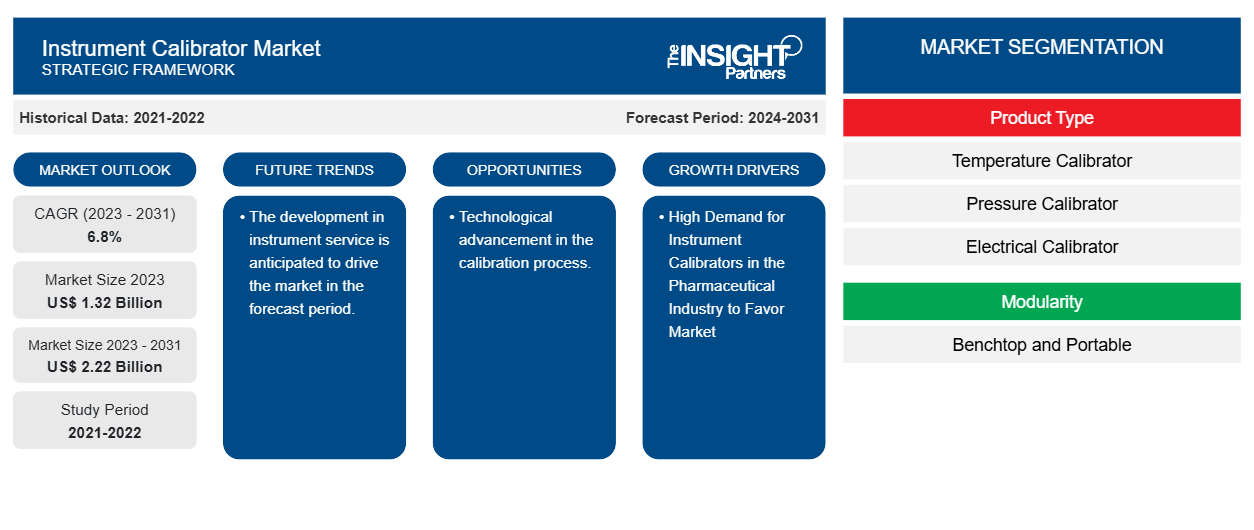Le marché des calibrateurs d'instruments devrait atteindre 2,22 milliards USD d'ici 2031, contre 1,32 milliard USD en 2023. Le marché devrait enregistrer un TCAC de 6,8 % au cours de la période 2023-2031. La demande croissante de l'industrie pharmaceutique, les progrès technologiques et l'accessibilité des calibrateurs devraient rester des tendances et des moteurs clés du marché.
Analyse du marché des calibrateurs d'instruments
La demande pour le marché des calibrateurs d'instruments devrait augmenter en raison de la demande croissante des industries pharmaceutique, aérospatiale et de la défense. En outre, diverses réglementations gouvernementales, avancées technologiques et étalonnage des instruments devraient stimuler le marché dans les années à venir.
Aperçu du marché des calibrateurs d'instruments
L'étalonnage des instruments est une partie importante de tout système de mesure. Il garantit que les instruments fonctionnent correctement et fournissent des mesures précises. Il s'agit du processus de comparaison entre les mesures d'un instrument et celles fournies par un instrument de référence ou un calibrateur. L'étalonnage permet de garantir la fiabilité, la précision, la sécurité et la conformité aux normes de l'industrie.
Personnalisez ce rapport en fonction de vos besoins
Vous bénéficierez d'une personnalisation gratuite de n'importe quel rapport, y compris de certaines parties de ce rapport, d'une analyse au niveau des pays, d'un pack de données Excel, ainsi que de superbes offres et réductions pour les start-ups et les universités.
-
Obtenez les principales tendances clés du marché de ce rapport.Cet échantillon GRATUIT comprendra une analyse de données, allant des tendances du marché aux estimations et prévisions.
Moteurs et opportunités du marché des calibrateurs d’instruments.
La forte demande d'étalonneurs d'instruments dans l'industrie pharmaceutique devrait favoriser le marché
L'étalonnage des instruments est une activité GMP essentielle dans l'industrie pharmaceutique. Elle garantit des mesures précises des instruments critiques et contribue à maintenir la qualité et la sécurité des produits. Ce processus consiste à comparer les instruments à des normes connues pour vérifier leur exactitude dans les limites de tolérance spécifiées. Les usines pharmaceutiques peuvent fonctionner sans étalonnage. Cependant, le respect des réglementations EMEA/FDA et des normes ISO strictes, sans parler de l'énorme quantité d'instruments nécessitant un étalonnage régulier, peut s'avérer un processus coûteux et chronophage. De grandes quantités de données d'étalonnage sont produites et archivées, qui doivent être facilement accessibles, notamment en cas d'audit. Cela crée une énorme demande d'étalonnage des instruments, ce qui alimente encore la croissance du marché.
Progrès technologique dans le processus d’étalonnage.
Les progrès technologiques dans le processus d'étalonnage offrent d'immenses opportunités. La demande de logiciels automatisés pour améliorer la précision et l'efficacité des processus augmente. Les logiciels d'automatisation de l'étalonnage peuvent être utilisés pour convertir les processus et procédures manuels en tâches à faible contact, voire sans contact. De plus, l'intelligence artificielle pour l'apprentissage profond et l'étalonnage intelligent gagne du terrain. De nouvelles applications de ces outils sont identifiées quotidiennement, et l'étalonnage est l'un des nombreux secteurs qui bénéficient de cet essor technologique. Ainsi, en raison des paramètres ci-dessus, les progrès technologiques dans le processus d'étalonnage devraient alimenter la croissance du marché dans les années à venir.benefitting from this technology boom. Thus, owing to the above parameters, technological advancement in the calibration process is anticipated to fuel the market growth in coming years.
Analyse de segmentation du rapport sur le marché des calibrateurs d'instruments
Les segments clés qui ont contribué à l’élaboration de l’analyse du marché des calibrateurs d’instruments sont le type de produit, la modularité et le secteur vertical.
- En fonction du type de produit, le marché des calibrateurs d'instruments est divisé en calibrateurs de température , calibrateurs de pression, calibrateurs électriques et calibrateurs de processus multifonctions. Le segment des calibrateurs de température devrait détenir une part importante au cours de la période de prévision.
- Basé sur la modularité, le marché des calibrateurs d'instruments est celui des paillasses et des appareils portables. Le segment portable devrait détenir une part importante au cours de la période de prévision.
- Le marché est segmenté en fonction des secteurs d'activité, notamment l'automobile, l'aéronautique et la défense, l'électronique, l'alimentation et les boissons, la pharmacie, le pétrole et le gaz, etc. Le secteur automobile devrait détenir une part de marché importante au cours de la période de prévision.
Analyse des parts de marché des calibrateurs d'instruments par géographie
La portée géographique du rapport sur le marché des calibrateurs d’instruments est principalement divisée en cinq régions : Amérique du Nord, Asie-Pacifique, Europe, Moyen-Orient et Afrique, et Amérique du Sud et centrale.
L'Amérique du Nord domine le marché. L'Amérique du Nord comprend des pays tels que les États-Unis, le Canada et le Mexique. La région connaît une croissance substantielle en raison de facteurs tels que la disponibilité des calibrateurs d'instruments de table et portables dans les économies développées et en développement. De plus, l'utilisation élevée des calibrateurs portables en raison de leur interface conviviale et de leurs prix abordables augmente leur demande à l'échelle mondiale. De plus, l'accent mis sur la recherche et le développement accroît les progrès technologiques dans la région. En outre, la région compte un grand nombre de fabricants clés sur le marché. Ainsi, en raison de tous ces paramètres, le marché gagne du terrain en Amérique du Nord.
Aperçu régional du marché des calibrateurs d'instruments
Les tendances régionales et les facteurs influençant le marché des calibrateurs d’instruments tout au long de la période de prévision ont été expliqués en détail par les analystes d’Insight Partners. Cette section traite également des segments et de la géographie du marché des calibrateurs d’instruments en Amérique du Nord, en Europe, en Asie-Pacifique, au Moyen-Orient et en Afrique, ainsi qu’en Amérique du Sud et en Amérique centrale.

- Obtenez les données régionales spécifiques au marché des calibrateurs d'instruments
Portée du rapport sur le marché des calibrateurs d'instruments
| Attribut de rapport | Détails |
|---|---|
| Taille du marché en 2023 | 1,32 milliard de dollars américains |
| Taille du marché d'ici 2031 | 2,22 milliards de dollars américains |
| Taux de croissance annuel composé mondial (2023-2031) | 6,8% |
| Données historiques | 2021-2022 |
| Période de prévision | 2024-2031 |
| Segments couverts |
Par type de produit
|
| Régions et pays couverts |
Amérique du Nord
|
| Leaders du marché et profils d'entreprises clés |
|
Densité des acteurs du marché : comprendre son impact sur la dynamique des entreprises
Le marché des calibrateurs d'instruments connaît une croissance rapide, tirée par la demande croissante des utilisateurs finaux en raison de facteurs tels que l'évolution des préférences des consommateurs, les avancées technologiques et une plus grande sensibilisation aux avantages du produit. À mesure que la demande augmente, les entreprises élargissent leurs offres, innovent pour répondre aux besoins des consommateurs et capitalisent sur les tendances émergentes, ce qui alimente davantage la croissance du marché.
La densité des acteurs du marché fait référence à la répartition des entreprises ou des sociétés opérant sur un marché ou un secteur particulier. Elle indique le nombre de concurrents (acteurs du marché) présents sur un marché donné par rapport à sa taille ou à sa valeur marchande totale.
Les principales entreprises opérant sur le marché des calibrateurs d'instruments sont :
- AMETEK Inc.
- La société Baker Hughes
- Instruments Extech
- Société Fluke
- Société d'électricité Yokogawa
- WIKAAlexander Wiegand SE & co. KG
Avis de non-responsabilité : les sociétés répertoriées ci-dessus ne sont pas classées dans un ordre particulier.

- Obtenez un aperçu des principaux acteurs du marché des calibrateurs d'instruments
Actualités et développements récents du marché des calibrateurs d'instruments
Le marché des calibrateurs d'instruments est évalué en collectant des données qualitatives et quantitatives après des recherches primaires et secondaires, qui comprennent d'importantes publications d'entreprise, des données d'association et des bases de données. Quelques-uns des développements sur le marché des calibrateurs d'instruments sont énumérés ci-dessous :
- ABB a commencé la construction d'un nouveau hall d'étalonnage de 12 000 pieds carrés dans le parc industriel adjacent à son usine de fabrication existante de 200 000 pieds carrés à Bartlesville, dans l'Oklahoma. L'investissement renforcera les capacités d'étalonnage de l'entreprise et offrira aux clients des niveaux élevés de qualité et de précision dans la gamme complète de débitmètres d'ABB. Il augmentera également l'offre « Made in America » de l'entreprise. (Source : site Web de l'entreprise ABB, janvier 2024)
- Dracal Technologies a annoncé la signature d'un accord entre Dracal Technologies et Essco Calibration Laboratory aux États-Unis. Essco est un laboratoire accrédité ISO/IEC 17025:2017 avec plus de 50 ans d'expérience dans l'étalonnage d'instruments de mesure. (Source : Dracal Technologies, site Web de l'entreprise, novembre 2023)
Rapport sur le marché des calibrateurs d'instruments et livrables
Le rapport « Taille et prévisions du marché des calibrateurs d’instruments (2021-2031) » fournit une analyse détaillée du marché couvrant les domaines ci-dessous :
- Taille et prévisions du marché des calibrateurs d’instruments aux niveaux mondial, régional et national pour tous les segments de marché clés couverts dans le cadre.
- Tendances du marché des calibrateurs d’instruments ainsi que dynamique du marché telles que les moteurs, les contraintes et les opportunités clés.
- Analyse détaillée des cinq forces de PEST/Porter et SWOT.
- Analyse du marché des calibrateurs d’instruments couvrant les principales tendances du marché, le cadre mondial et régional, les principaux acteurs, les réglementations et les développements récents du marché.
- Analyse du paysage industriel et de la concurrence couvrant la concentration du marché, l’analyse de la carte thermique, les principaux acteurs et les développements récents pour le marché des calibrateurs d’instruments.
- Profils d'entreprise détaillés.
- Analyse historique (2 ans), année de base, prévision (7 ans) avec TCAC
- Analyse PEST et SWOT
- Taille du marché Valeur / Volume - Mondial, Régional, Pays
- Industrie et paysage concurrentiel
- Ensemble de données Excel
Rapports récents
Témoignages
Raison d'acheter
- Prise de décision éclairée
- Compréhension de la dynamique du marché
- Analyse concurrentielle
- Connaissances clients
- Prévisions de marché
- Atténuation des risques
- Planification stratégique
- Justification des investissements
- Identification des marchés émergents
- Amélioration des stratégies marketing
- Amélioration de l'efficacité opérationnelle
- Alignement sur les tendances réglementaires























 Obtenez un échantillon gratuit pour - Marché des calibrateurs d'instruments
Obtenez un échantillon gratuit pour - Marché des calibrateurs d'instruments